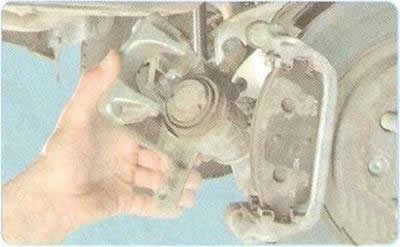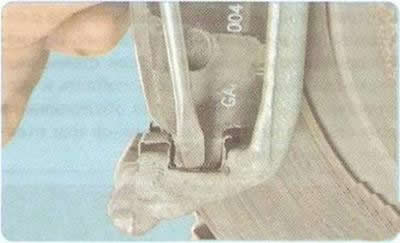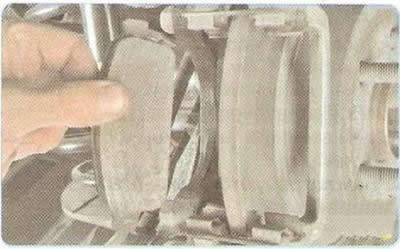Brake pads must be replaced when the pads are worn (minimum allowable thickness of friction linings 2 mm), loose connection of linings with the base, oiling of working surfaces, the presence of deep grooves or chips.
Warning: Replace the rear brake pads only as a set - 4 pcs. (two on each side).
Before replacing the brake pads, check the brake fluid level in the master cylinder reservoir. If the level is close to the upper mark, it is necessary to pump out part of the liquid: after replacing the worn pads with new ones, the level will rise.
1. Remove the rear wheel from the side to be replaced.

2. Turn out the top and bottom bolts of fastening of directing fingers of a support.

3. Remove the caliper from the disc without disconnecting the brake hose from the caliper, and secure with wire to the suspension elements...

4.... while the brake pads will remain in the guide.
5. Use a flat-blade screwdriver to pry out the top...

6.... and the lower retainers of the retaining spring.

7. Remove the outer...

8....and internal brake pads.
9. Remove the bottom and top retaining plates from the shoe guide.
Note: In order to reduce the vibration of the brake pads when the wheels rotate, retaining plates are installed in the grooves of the pad guide. When installing the pads, replace them with new ones.
10. Drown the piston of the working cylinder (see «Checking the degree of wear of brake pads and discs»).
11. Establish retaining plates, brake shoes in directing and other details in an order, the return to removal. To prevent self-loosening of the caliper guide pin bolts, lubricate their threads before installation with an anaerobic thread locker.
Note: The outer brake pads are symmetrical and fit on both rear wheels. Internal brake pads are not symmetrical (on the outer side of the block are inscribed «INBOARD» and an arrow indicating the direction of rotation of the brake disc). Install the inner brake pads with the arrow pointing up.
12. Press the brake pedal all the way down several times. This is necessary in order to select the gaps in the brake mechanism that appeared after the pistons were pressed into the cylinders.
13. Install the wheel.
14. Similarly, replace the brake pads of the brake mechanism of the other rear wheel.

15. Check up and if necessary restore level of a brake liquid in a tank of the main brake cylinder.
Helpful Hints: After replacing worn-out brake pads with new ones, do not rush to immediately drive onto busy highways. It is possible that at the very first intensive braking you will be unpleasantly surprised by the low efficiency of the brakes, although the pads were branded. Brake discs also wear out, and new pads only touch them at the edges, with little to no braking. Choose a quiet street or passage without cars and slow down gently several times so that the pads get used and begin to fit the entire surface. At the same time, evaluate the effectiveness of the brakes.
Try not to brake sharply for at least the first 100 km. With strong heating of unused pads, the top layer of their linings burns and the brakes will not be as effective as possible for a long time.
